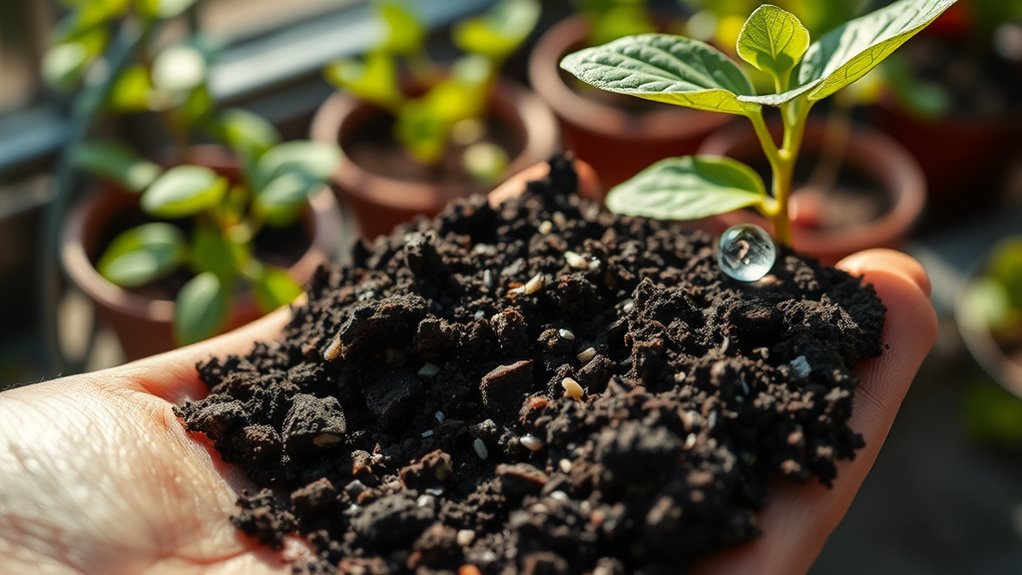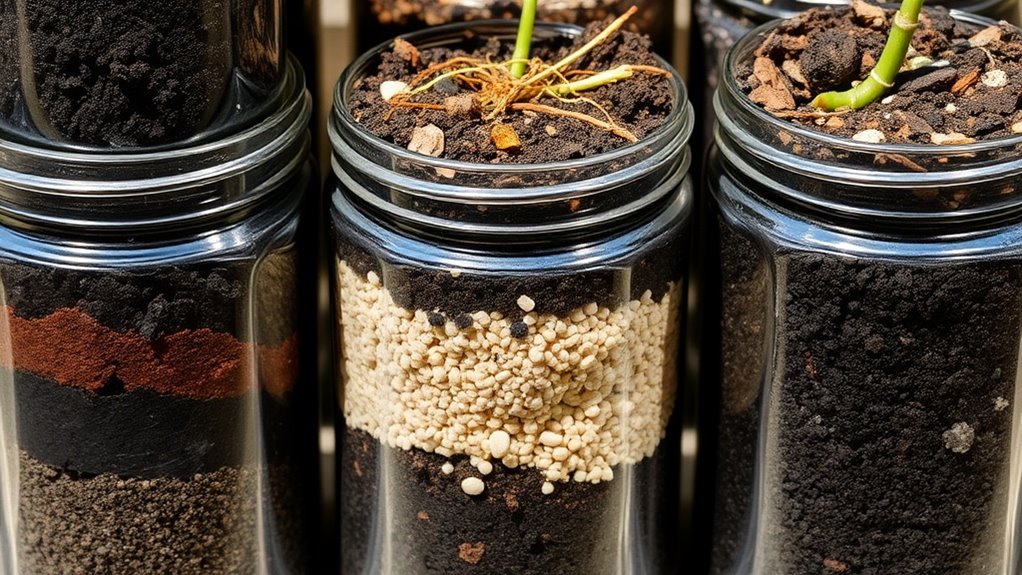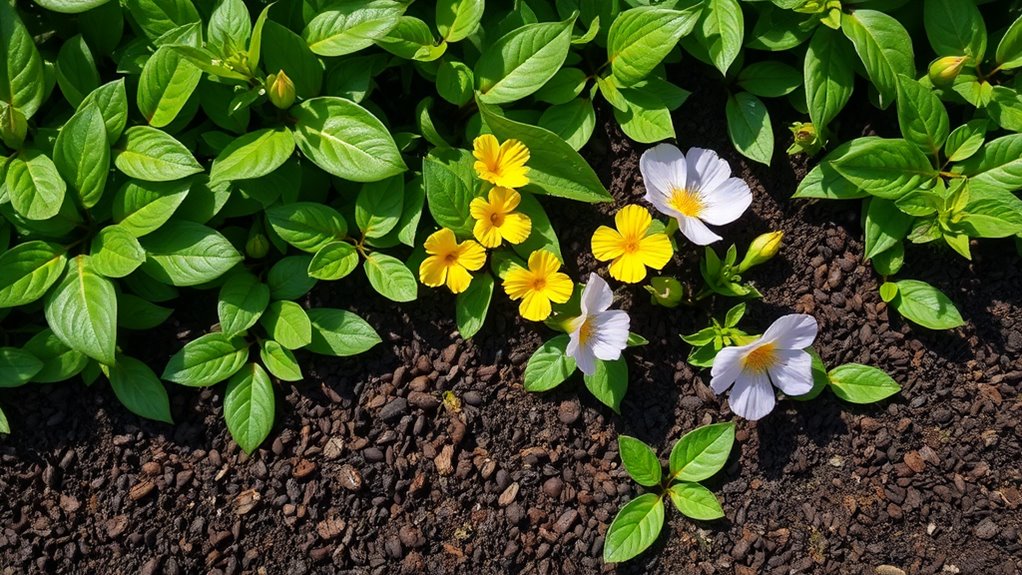The Truth About Store-Bought Soil – What You Need to Know
When selecting store-bought soil, you should understand its composition, which typically includes organic matter, peat moss, and perlite. These components improve aeration and drainage while supporting healthy root systems. Nutrient content is vital; nitrogen, phosphorus, and potassium influence growth. Additionally, consider the soil’s pH and moisture retention capabilities to cater to your plants’ specific needs. Knowing the difference between organic and synthetic options can also guide your choice. Explore further to uncover more essential insights and tips.
Understanding the Composition of Store-Bought Soil
Have you ever wondered what actually makes up store-bought soil?
Typically, it consists of a mix of organic matter, peat moss, perlite, and sometimes vermiculite.
This combination provides aeration and drainage, essential for healthy root systems.
You’ll often find added fertilizers to kickstart plant growth.
When choosing soil, consider your plants’ specific needs—different plants require different soil types.
Here are some soil tips: check for pH levels, look for moisture retention capabilities, and guarantee it’s free of pests.
Understanding these components helps you select the right soil for ideal plant health and thriving gardens. Additionally, it’s important to note that store-bought soil mixes can sometimes lack the specific nutrients and conditions that certain plants thrive in.
The Role of Nutrients in Soil Quality
Understanding the composition of store-bought soil sets the stage for recognizing the importance of nutrients in overall soil quality.
Essential nutrients like nitrogen, phosphorus, and potassium, commonly referred to as NPK, directly influence plant growth.
Nitrogen fosters leafy development, phosphorus supports root and flower formation, and potassium enhances overall plant health.
Micronutrients, though needed in smaller amounts, are equally essential for biochemical processes.
When choosing store-bought soil, check for nutrient content to guarantee it meets your plants’ needs.
A balanced nutrient profile not only improves plant vitality but also enhances soil structure and microbial activity, fostering a thriving ecosystem.
Additionally, regular soil testing can help identify specific nutrient deficiencies and guide you in selecting the most suitable soil amendments.
Evaluating Soil Texture and Drainage
To effectively evaluate store-bought soil, you need to understand its composition, which influences both texture and drainage.
Evaluating the drainage capabilities will help guarantee your plants receive the right moisture levels, while identifying texture types—like sandy, clay, or loamy—provides insight into how nutrients are retained. This analysis is essential for optimizing plant health and growth. Additionally, being aware of common soil myths can prevent you from making misconceptions that could hinder your gardening success.
Understanding Soil Composition
Soil composition plays a crucial role in determining how well your plants thrive, and evaluating soil texture and drainage is essential for successful gardening.
The texture, defined by the proportions of sand, silt, and clay, influences water retention and root penetration.
Sandy soils drain quickly but lack nutrients, while clay retains moisture but can compact easily.
Loamy soils, a balanced mixture, offer ideal conditions.
To assess texture, perform a simple jar test: mix soil with water and observe layer separation.
Understanding these characteristics allows you to select appropriate amendments, ensuring your chosen soil supports healthy plant growth effectively.
Assessing Drainage Capabilities
How can you make sure your plants receive the right amount of moisture?
Evaluating drainage capabilities is key.
Start by observing the soil’s texture; well-draining soil should allow water to pass through quickly without pooling.
You can conduct a simple drainage test by digging a hole, filling it with water, and timing how long it takes to drain.
Ideally, it should drain within 1-2 hours.
If it takes longer, the soil may retain too much moisture, leading to root rot.
Understanding these drainage characteristics helps you select the right soil for your plants’ specific moisture needs and overall health.
Identifying Texture Types
Ever wondered what makes up the different textures of soil? Soil texture primarily consists of sand, silt, and clay, each influencing drainage and nutrient retention.
To identify texture, perform the “ribbon test”: moisten soil, then squeeze it. If it holds shape and forms a ribbon, it’s clay. If it crumbles easily, it’s sandy. A mix indicates loamy soil.
Additionally, observe drainage characteristics; sandy soils drain quickly, while clay soils retain water.
Understanding these textures helps you select the right store-bought soil for your gardening needs, ensuring ideal plant growth and health.
Organic vs. Synthetic Soil Options
When choosing between organic and synthetic soil options, it’s essential to understand their distinct benefits and drawbacks.
Organic soil typically enhances soil health and promotes biodiversity, while synthetic alternatives may provide quick nutrient availability but can harm long-term soil quality. Additionally, consider the environmental impact of your choice, as synthetic soils often contribute to pollution and degradation. Using secret organic gardening hacks can further improve your soil’s vitality and support healthier plant growth.
Benefits of Organic Soil
Organic soil offers numerous advantages over synthetic options, making it a popular choice among gardeners and plant enthusiasts.
It enhances soil structure, providing better aeration and drainage, which promotes healthy root development.
Rich in beneficial microorganisms, organic soil boosts plant resilience and nutrient uptake.
Additionally, it improves moisture retention, reducing the need for frequent watering.
By using organic amendments, you secure a sustainable ecosystem, promoting biodiversity in your garden.
Organic soil also minimizes chemical runoff, protecting surrounding water sources.
Ultimately, when you choose organic, you cultivate healthier plants while contributing to a more sustainable environment.
Drawbacks of Synthetic Soil
What makes synthetic soil less favorable for gardeners?
Synthetic soil often lacks essential microorganisms and organic matter, which are vital for healthy plant growth.
Its uniform texture may not retain moisture effectively, leading to frequent watering and potential plant stress.
Additionally, synthetic options can contain chemical additives that might inhibit plant development and harm beneficial soil life.
Nutrient release in synthetic soil can be unpredictable, making it difficult to manage fertilization.
Finally, reliance on synthetic soil can create a cycle of dependency, preventing gardeners from developing their own healthy, self-sustaining ecosystems.
Consider these drawbacks carefully before choosing synthetic options.
Environmental Impact Considerations
How do your soil choices impact the environment?
When you opt for synthetic soil, you often contribute to chemical runoff, which can harm local waterways and ecosystems.
These products typically contain fertilizers and pesticides that can leach into groundwater.
In contrast, organic soil options promote biodiversity and enhance soil health without harmful additives.
They support beneficial microorganisms, improving nutrient cycling and soil structure while reducing the need for chemical interventions.
By choosing organic, you help mitigate pollution and promote sustainable agricultural practices.
Ultimately, your soil choice plays a vital role in fostering a healthier, more resilient environment.
The Impact of Soil Ph on Plant Health
Have you ever wondered why some plants thrive while others struggle in the same soil?
A key factor is soil pH, which affects nutrient availability and microbial activity.
Ensuring your soil’s pH is appropriate for your plants can make a significant difference. Soil testing is an essential step in understanding and optimizing your soil’s pH levels.
Here’s how it impacts plant health:
- Nutrient absorption: Certain nutrients become unavailable outside specific pH ranges.
- Root development: Extreme pH levels can hinder root growth and function.
- Microbial activity: Beneficial microbes thrive in ideal pH, enhancing nutrient cycling.
- Disease resistance: Proper pH can strengthen plants’ defenses against pathogens.
Test your soil regularly to maintain ideal pH for healthy plants.
Common Additives and Their Effects
Maintaining the right soil pH is just one part of creating an ideal growing environment; the choice of soil additives can greatly influence plant health as well. Common additives include perlite, vermiculite, and peat moss. Each serves a specific purpose, enhancing aeration, moisture retention, or nutrient availability. Additionally, you can enhance your soil naturally by using readily available materials from your own backyard.
| Additive | Effect | Best For |
|---|---|---|
| Perlite | Improves drainage | Cacti and succulents |
| Vermiculite | Enhances moisture retention | Seed starting |
| Peat Moss | Increases organic matter | Acid-loving plants |
Choosing the right additive can optimize your soil’s performance and support your plants’ growth.
Tips for Choosing the Right Soil for Your Plants
Choosing the right soil for your plants can greatly impact their growth and overall health.
To guarantee you select the best option, consider the following tips:
- Know your plants: Different species require specific soil types for ideal growth.
- Check drainage: Good soil should retain moisture but also allow excess water to drain.
- Examine pH levels: Many plants thrive in slightly acidic soils, so test and adjust as needed.
- Look for organic matter: High-quality soils contain compost or other organic materials that enrich nutrients. Additionally, soil prep techniques can enhance the effectiveness of your chosen soil, ensuring your plants flourish.





